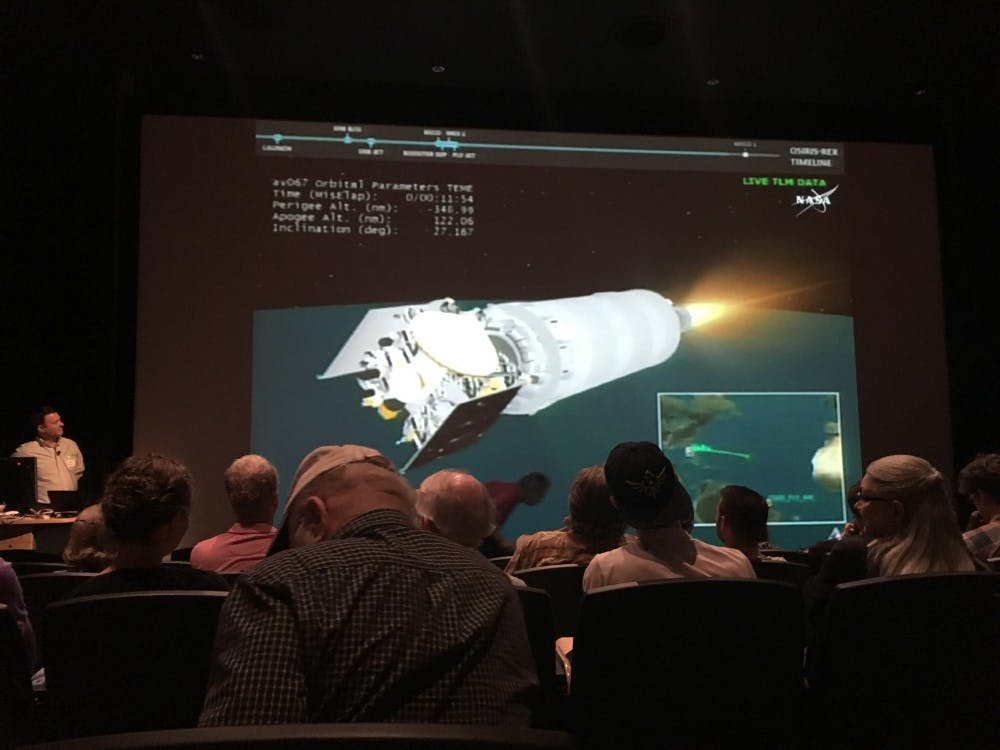Millions of dollars of technology was launched out of the earth’s atmosphere on top of an Atlas 5 rocket on Sept. 8, and a team of over 40 ASU students and faculty watched with bated breath as the OSIRIS-REx spacecraft began its journey to a nearby asteroid.
This excitement wasn't out of place, as the University has a significant stock in the expedition. On board the spacecraft is a camera, dubbed the OSIRIS-REx Thermal Emission Spectrometer, developed by researchers at the ASU School of Earth and Space Exploration.
“People put three to five years of their careers into this, and then you put it on top of a bomb on purpose," said Jim Bell, a professor a researcher involved in the project. "Of course you’re nervous."
Despite high nerves, the launch went off without a hitch.
“Events like this, they don’t happen too terribly often, and there’s plenty of people here who worked on OSIRIS-REx,” Kelley Liebst, an astrophysics graduate student who attended the watch party to celebrate the liftoff, said. “It’s really cool to be connected.”
The craft will be investigating an asteroid called Bennu that will be key in future astronomical research.
“It’s the target of this mission for two reasons," said Bell. "One, it’s relatively easy to get to. It orbits fairly close to the earth. So it’s relatively close to us, easy to get to and get back from. It’ll take a couple of years to loop around and catch up with that asteroid.”
The other reason, Bell said, was the composition of Bennu.
“Because not all asteroids are the same,” he said. "(Asteroids such as Bennu) may be responsible for us being here today. They may have delivered most or all of the oceans. They may have delivered most or all of the organic molecules (on earth).”
Researchers hope to obtain samples from this asteroid to learn more about how the solar system was formed, billions of years ago.
“This asteroid is primitive,” said Bell. “It’s possible that nothing has happened to it in four and a half billion years, since it condensed out of the spinning cloud of dust and gas that formed our solar system.”
This expedition is something of a follow-up to one conducted by Japanese researchers to a different asteroid.
“That really didn’t work as planned,” Bell said. “The sampling device touched the surface but didn’t really close the door up, but they had to seal the container up. They sealed up the container and sent it back to earth.”
The OSIRIS-REx mission to obtain new samples is simple — at least on paper.
“The spacecraft takes a couple of years mapping and imaging and ... other kinds of measurements, figuring out ‘Where do we touch down and get that sample?'” Bell said. “It’ll take a couple of years to figure that out. They’ll find the sweet spot.”
Finding that spot is where the ASU technology comes in.
“(The team built) a type of camera that uses spectroscopy,” Jefferson Fleming, a docent for the School of Earth and Space Exploration who helped design one of the satellite's main cameras, said.
Fleming said the camera captures a special image and analyzes it to find different minerals.
“Spectroscopy works kind of like the Pink Floyd album," he said. "White light comes in, color comes out. We can do the same thing with light from the sun, but the thing is, you get these little gaps in the rainbow spectrum of light, which is the signature of the elements. So certain black lines that are missing ... can be the result of hydrogen."
Scientists at NASA will use this data to pick the best spot possible to extract a sample of the asteroid and package it up to send back to earth.
“Inside that canister, which won’t be much bigger than a basketball, will be pieces of our origin story,” Bell said. “Pieces of the origin of the solar system.”
Reach the reporter at ckmccror@asu.edu or follow @ckm_news on Twitter.
Like The State Press on Facebook and follow @statepress on Twitter.




